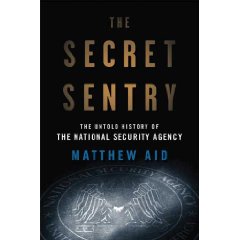
by Matthew M. Aid.
Bloomsbury, 423 pp., $30.00
REVIEW BY James Bamford
The New York Review of Books (5 November 2009)
Pre-released in The Huffington Post (Full Review Here)
Bamford's trilogy on NSA in reverse chronological order:
The Shadow Factory: The NSA from 9/11 to the Eavesdropping on America
Body of Secrets: Anatomy of the Ultra-Secret National Security Agency
The Puzzle Palace: Inside the National Security Agency, America's Most Secret Intelligence Organization
We know Matthew Aid, his book should be considered a follow-on to the work of James Bamford, but as Bamford himself observes, the book on NSA leadership's high crimes and misdemeanors has yet to be written–it will start with fraud, waste, and abuse, and end with warrantless wiretapping and gross dereliction of duty.
EXCERPTS From Bamford's Full Review:
Because the book is structured chronologically, it is somewhat difficult to decipher the agency's overall record. But one sees troubling trends. One weakness that seems to recur is that the agency, set up in the wake of World War II to prevent another surprise attack, is itself frequently surprised by attacks and other serious threats.
. . . . . . .
The most troubling pattern, however, is that the NSA, through gross incompetence, bad intelligence, or deliberate deception through the selective release of information, has helped to push the US into tragic wars.
A prime example took place in 1964 when the Johnson administration claimed that two US Navy destroyers in the Gulf of Tonkin, one on an eavesdropping mission for the NSA, were twice attacked by North Vietnamese torpedo boats. Those attacks were then used to justify the escalation of American involvement in the Vietnam War. But Aid cites a top-secret NSA analysis of the incident, completed in 2000, which concluded that the second attack, the one used to justify the war, never took place. Instead, NSA officials deliberately withheld 90 percent of the intelligence on the attacks and told the White House only what it wanted to hear. According to the analysis, only intelligence “that supported the claim that the communists had attacked the two destroyers was given to administration officials.”
Not having learned its lesson, in the lead-up to the war in Iraq the NSA again told the administration only what it wanted to hear, despite the clearly ambiguous nature of the evidence.
. . . . . . .
While much of the terrain Aid covers has been explored before, the most original areas in The Secret Sentry deal with the ground wars in Afghanistan and Iraq, where the NSA was forced to marry, largely unsuccessfully, its super-high-tech strategic capabilities in space with its tactical forces on the ground.
. . . . . . .
Disappointingly, the weakest section of the book, mostly summaries of old news clips, deals with what may be the most important subject: the NSA's warrantless eavesdropping and its targeting of American communications. There is no discussion, for example, of the agency's huge data-mining centers, mentioned above, currently being built in Utah and Texas, or to what extent the agency, which has long been confined to foreign and international communications, is now engaged in domestic eavesdropping. It is a key question and we have no precise answer. By installing its intercept rooms in such locations as AT&T's main switching station in downtown San Francisco, the agency has physical access to domestic as well as international communications.
. . . . . . .
Aid's history becomes thin as it gets closer to the present day and the archival documents dwindle, especially since he has no substantial first- person, on-the-record interviews. Beyond a brief mention, he also leaves other important aspects of the NSA's history unaddressed, including the tumultuous years in the mid-1970s when it was investigated by the Senate's Church Committee for decades of illegal spying; Trailblazer, the nearly decade-long failure to modernize the agency; and the NSA's increasingly important role in cyberwarfare and its implications in future wars.
. . . . . . .
Aid concludes that the biggest problem facing the agency is not the fact that it's drowning in untranslated, indecipherable, and mostly unusable data, problems that the troubled new modernization plan, Turbulence, is supposed to eventually fix. “These problems may, in fact, be the tip of the iceberg,” he writes. Instead, what the agency needs most, Aid says, is more power. But the type of power to which he is referring is the kind that comes from electrical substations, not statutes. “As strange as it may sound,” he writes, “one of the most urgent problems facing NSA is a severe shortage of electrical power.” With supercomputers measured by the acre and estimated $70 million annual electricity bills for its headquarters, the agency has begun browning out, which is the reason for locating its new data centers in Utah and Texas. And as it pleads for more money to construct newer and bigger power generators, Aid notes, Congress is balking.
. . . . . . .
Based on the NSA's history of often being on the wrong end of a surprise and a tendency to mistakenly get the country into, rather than out of, wars, it seems to have a rather disastrous cost-benefit ratio. Were it a corporation, it would likely have gone belly-up years ago. The September 11 attacks are a case in point. For more than a year and a half the NSA was eavesdropping on two of the lead hijackers, knowing they had been sent by bin Laden, while they were in the US preparing for the attacks. The terrorists even chose as their command center a motel in Laurel, Maryland, almost within eyesight of the director's office. Yet the agency never once sought an easy-to-obtain FISA warrant to pinpoint their locations, or even informed the CIA or FBI of their presence.



